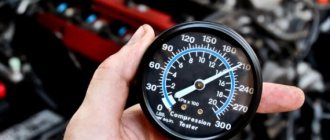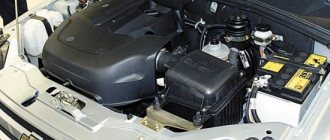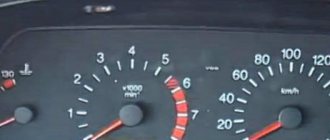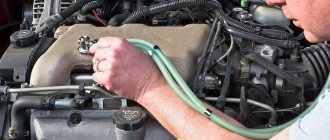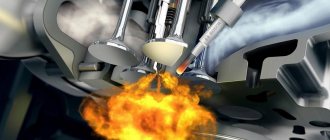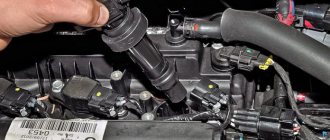It happens that you urgently need to go to work, but the car, after sitting all night, will not start. So why does a vehicle that is in good working order after the last trip suddenly refuse to start? Or does it stall as soon as you crank the engine? Let's look at the reasons why a car may have difficulty starting when cold.
First of all, it is necessary to make a reservation - your car starts perfectly if the engine has not had time to cool down, but in the case when the vehicle sits until the engine has completely cooled down, starting is difficult or completely impossible. In such a situation, even modern systems for heating and maintaining engine temperature do not always help. Let us consider in more detail the situation when a cold engine does not start well.
Poor quality fuel
It happens that even at gas stations of well-known brands, you can fill up with low-quality fuel, and then bite your elbows because the car does not start or starts, but with difficulty. It is very difficult to determine this probability, since when you leave the gas station, the car is still running on the old fuel, and will work until new fuel enters all the fuel channels of the car.
Main types of low-quality fuel:
- Contaminated fuel is fuel that contains various deposits. They contaminate fuel channels, wires and filters. As a result, gasoline pressure drops and the car does not start.
- Low octane number. As a rule, with such fuel, the car starts cold the second or even the third time, you can hear how noisy the engine is, traction disappears, and detonation occurs. It is not recommended to start a car on such fuel; it is better to drain it immediately and fill it with high-quality fuel.
Causes of poor engine starting
There are several reasons that affect starting a car when it is cold, these include:
- Low quality fuel. Often, poor engine starting is caused by low quality fuel. In this case, there is a high probability of clogging of the fuel filter and injectors.
- Air filter. The air filter may become dirty; replacing it is quite simple, without the help of specialists, and completely solves this problem.
- Bad spark plugs, clogged fuel pump. Problems starting a car with a cold engine can occur due to a clogged fuel pump or bad spark plugs.
- Low compression. A decrease in pressure in the combustion chamber occurs due to engine wear or incorrect installation of the timing belt.
- Incorrectly selected fuel. On diesel engines, poor starting is often caused by incorrectly selected fuel. Such units require a strict seasonal change in the types of diesel fuel (“winter”, “summer”, and for particularly cold regions - “Arctic”).
- Excess fuel supply. Sometimes poor starting of a car when cold is caused by an excess or, on the contrary, a lack of fuel when supplied. In winter, spark plugs on injection engines often flood (as a rule, this only occurs in used cars). It is not difficult to correct the situation; in this case, they need to be unscrewed and dried.
- Throttle valve dirty. A fairly common reason that affects the engine starting when cold. In this case, it does not open completely, which is why the engine does not work properly.
- Sensor failure. Another reason why the injection unit does not start well is the failure of the sensors (DPS, DPRV, DMRV).
- There is a fault in the electrical circuit. When the battery provides a charge, but there is no spark at the spark plugs, it is worth checking the integrity of the high-voltage wires and the functionality of the ignition coil. However, it is worth knowing that in the event of such a breakdown, problems with starting will arise only on a cold engine.
- Dirty idle valve. In rare cases, the cause of poor engine starting is the idle air valve, which has not been cleaned for a long time. After cleaning it, such problems will disappear.
Important! If, when you try to start the engine, smoke is visible from the exhaust pipe, but the car does not start, this means that fuel is being supplied, but it is not ignited.
Starting in cold weather
Tips for winter starting the engine
If your car has trouble starting in cold weather, following simple rules can correct this situation.
- Try to keep your fuel tank full to help prevent condensation from forming and mixing water with fuel. This way the quality of the fuel will not deteriorate.
We recommend: Popping sounds in the muffler - how to fix it yourself?
A car that runs on gas and cannot start well when cold - never start it without switching to gasoline! Is it dangerous!
- Before starting the engine, when it is frosty outside, it is advisable to turn on the high beams and turn them off after a couple of seconds. This procedure will help partially restore the battery capacity and eliminate poor starting in cold weather.
- Before starting a car with a carburetor, you need to pump up the fuel a little (be careful not to fill the spark plugs!).
- After turning the key in the ignition, if the car has an injector, do not rush to start the engine. It is worth waiting a while for the required pressure in the fuel system to rise.
Ignition system malfunction
Another common option that makes a cold engine difficult to start is a malfunction of the ignition system.
Very often, due to temperature changes, microcracks occur in the ignition coils. As we know, when a body is hot it expands. In our case, the distance between the walls of the crack becomes minimal and the microcrack does not give a breakdown, but when cold, the bodies return to their original state, the microcrack increases in size and gives a breakdown to the engine housing or body. The spark does not reach the spark plug, the mixture in the cylinder does not ignite, and the car does not start well.
This problem is inherent not only to ignition coils, but also to any other elements that participate in this process - distributor, armored wires and even spark plugs.
Carburetor
The main reasons for poor starting of a carburetor engine after cooling to a cold state is the failure of the ignition distributor. Determined by cranking the starter - it turns out that the engine does not “grab.” The next reason is the ignition coil, the serviceability of which is checked with a multimeter. The switch, distributor, or carburetor settings may also be faulty. If a car with a carburetor is very difficult to start when cold, or after that it starts and stalls, this indicates a breakdown of the diaphragm in the starting device.
Problems with electronic sensors.
Modern gasoline cars are equipped with fuel injection systems that inject fuel electronically. These systems are equipped with many special sensors. If a breakdown occurs with one of these sensors, the corresponding signals will not be sent to the main control unit, as a result of which the engine will no longer start normally. First of all, you will need to check the following three sensors:
- DPRV sensor, which indicates the correct location of the camshaft;
- TPS sensor. It gives signals about the main positions of the damper;
- Mass air flow sensor, which indicates the air flow in the system.
[custom_ads_shortcode3]
Take care in advance
In general, in cold weather, the alarm system’s already weakened battery is additionally drained. If the car is stored in a guarded parking lot, it is better to leave it unguarded, thereby increasing the chances of starting in the morning. In order to open the doors without problems, you need to keep a can of a composition called “lock defroster” in your clothing pocket all winter. It costs a penny, but it helps a lot when the key refuses to even “go” into the hole. If you don’t have a defroster at hand, you’ll have to test the old-fashioned method for yourself - warm the key with a lighter.
We recommend: Lada Priora won’t start - what to do?
By the way, if you inject the same defroster or WD-40 into the lock in advance of frost, practically no water gets there. Do not use brake fluid to dissolve ice or treat locks. The lock may open, but by the evening it will freeze again, because, unlike special fluids, the brake fluid does not repel water, displacing it from the lock. In addition, it easily damages car paint.
Also, in severe frosts at night you can go out to warm the engine. Or pay parking attendants to warm up your car overnight. If possible, place it in the garage. Even in an unheated room, the temperature is 5-7 degrees higher than outside. And these are “two big differences” – minus 27 or minus 20.
If you still can’t start, and you have enough time, then you can try to determine the composition of the fuel mixture. To do this, simply remove one of the spark plugs from the engine and inspect it. If there are black (or very dark) deposits, the fuel mixture is quite rich, which means that there is something wrong with the car’s ignition system. Most often, in such cases, it is enough to replace the spark plugs, and engine starting returns to normal.
If there is no dark carbon deposit on the removed spark plug or it is white, we are talking about a lean fuel mixture. In this case, the culprit of the problem is often the coolant temperature sensor. You will always have problems with this - you will have to replace it.
When the fuel mixture is lean, some car owners try to start the engine using various additives that increase the octane number of the fuel. Sometimes they succeed. Another method that is often used in this situation is the injection of ether compounds to start carburetor engines. However, dealing with depressurization of the intake tract in the cold, and then doing all this in the reverse order, is not a pleasant task.
Another reason for a lean fuel mixture can be insufficient fuel pressure in the system. There are mainly two reasons here. This is either a dying fuel pump or a fuel pressure regulator. If there is a problem with the fuel pump, it may be impossible to start the engine. But sometimes the fuel pressure in the system can be raised to the optimal level by plugging the drain hose by squeezing it. This must be done carefully, as it may burst in severe frost. After starting the engine, you should not continue to pinch the hose. Otherwise, there is a high probability that the spark plugs will be splashed with too rich a fuel mixture. If this happens and the engine stalls, allow the mixture to evaporate by waiting 5-10 minutes. Or clean the spark plugs.
We recommend: Why does the engine stall at idle? Possible causes and action plan
The most common cause of problems starting a cold engine can be the usual depressurization of the intake tract. Most often we are talking about a slipped (sometimes burst) tube that connects the fuel pressure regulator in the system to the intake manifold. Carefully inspect the connections of all tubes (hoses, etc.) that go from the intake tract to other systems or elements (brake system, adsorber, crankcase ventilation, etc.), and if there are serviceable elements of the injection system, problems with cold starting on your car will not.
Tips for starting the engine in cold weather:
- Keep the tank full - this will prevent condensation from forming and water will not get into the fuel.
- Turning on the high beams for a couple of seconds before starting will restore some of the battery capacity on frosty days.
- After turning the key in the ignition switch (on an injection car), wait a few seconds until normal pressure is created in the fuel system, and only then start the engine.
- Pump up gasoline manually (on a carburetor car), but you must not overdo it, otherwise the spark plugs will flood.
- Cars run on gas, under no circumstances should you start them cold, switch to gasoline first!
About DTOZH
In general, power unit temperature sensors are the most important regulators of an injection engine. There are two of them on it. One is located directly in the cylinder head, it displays the temperature value on the instrument panel.
The second one is located in the thermostat, and provides data on the temperature of the control unit of the power unit. Based on the results obtained, the control unit regulates the fuel supply - it supplies more fuel to a cold internal combustion engine, and less to a hot one. In addition, it is the control unit that regulates the OZ, influences the ignition of the fuel assembly, and activates the coolant fan if the liquid temperature rises above 100 °C.
Obviously, with faulty DTOZh there will be difficulties in the operation of the motor. However, this applies more to the DTOZH, which provides information directly to the block. For example, if the DTOZH is faulty, it will give false values about a cold engine, although it is already boiling.
The supply of fuel to the cylinders will increase, because this is provided by the system. Let's say you drove for a long time, then stopped and went into a store. Now starting the power unit will cause obvious displeasure, since it will take a very long time to start due to data failures and oversaturation.
Why does the injector take a long time to start due to DTOZhO At the same time, the OZ, which is responsible for the ignition of the fuel assembly, which is clearly over-enriched, changes greatly. As a result, the fuel will evaporate intensively, and the concentration of gasoline in the fuel assembly will be so high that the mixture will hardly ignite due to the small amount of oxygen.
It was said above that when you press the accelerator pedal, the startup time will be noticeably reduced. Now it becomes clear why this happens. By pressing the gas, we add oxygen to the fuel assembly, and the fuel ignites faster.
Thus, by replacing a faulty DTOZh, you can solve not only the problem with long-term starting of the internal combustion engine, but also other difficulties relating to the process of engine operation and its cooling system. The engine, after replacing the faulty DTOZH, will add stability, throttle response and power.
[custom_ads_shortcode2]
HBO for cars
A hot engine can also cause a breakdown in the case of an installed gas system. Since driving on gas has recently become profitable, many drivers switched to this type of fuel, however, they did not take into account some of the nuances of the new system. In hot weather, gas expands more, which leads to increased pressure inside the system and often causes damage. This is why it is bad to drive on gas in the heat.
At high temperatures, seals and hoses can fly off, which leads to gas leakage.
The result is an extremely dangerous situation. To avoid this, try not to fill the tank to full gas in the summer, this will reduce the pressure in the system and the risk of breakdown. If a similar problem occurs, it is recommended to let the car cool down and then visit a service station. You should not repair the gas system yourself; the equipment should be adjusted by a specialist.
Oil too thick
As you know, diesel engines use a different lubricant than gasoline engines. However, this does not insure the car against difficult starts, especially in winter. As the temperature drops, the engine oil begins to thicken. Even with a charged battery, it will be difficult for the starter to turn the flywheel, and with it the crankshaft. Typically, diesel engines use motor oil with a viscosity of 15W-40.
When operating in extreme conditions, experts recommend lowering the bar to 5W-30. Thinner oil helps the crankshaft rotate more easily, which is especially important for an engine with lower temperatures.
